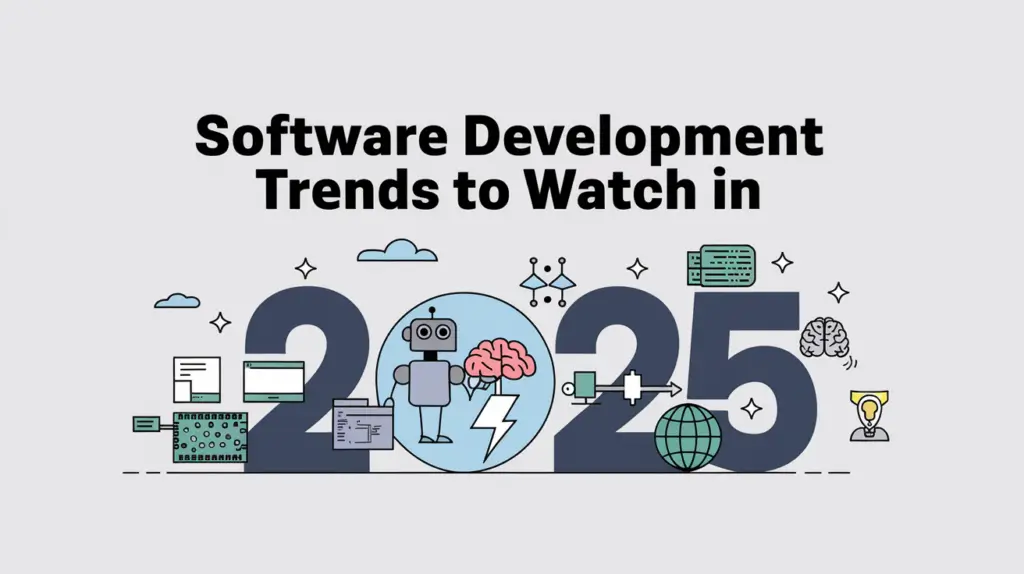If you have any query email us: info@softtechpro.cloud

The world of software development never stands still—and 2025 is no exception. From AI-driven coding assistants to smarter, faster cloud-native applications, the tools and trends shaping the industry are evolving rapidly.
Whether you’re a CTO, product owner, startup founder, or part of a growing dev team, staying on top of the latest trends isn’t just about looking smart—it’s about staying competitive.
Here are the top software development trends for 2025, and more importantly, why they actually matter for your business.
🤖 AI-Augmented Development Goes Mainstream
Artificial Intelligence is no longer a novelty in software development—it’s becoming a necessity. Tools like GitHub Copilot, Amazon CodeWhisperer, and Google Gemini Code are transforming how developers write, review, and optimize code.
Why It Matters:
- Faster time to market – AI can automate boilerplate code, testing, and even debugging.
- Enhanced productivity – Developers can focus on complex logic while AI handles the repetitive parts.
- Fewer bugs – Smarter suggestions and early detection reduce errors in production.
Tip: Teams embracing AI-enhanced coding can increase delivery speed by up to 30–50% without compromising quality.
☁️ Cloud-Native and Serverless Architectures Take Over
As businesses scale, traditional server management is giving way to cloud-native and serverless solutions. Platforms like AWS Lambda, Google Cloud Run, and Azure Functions allow teams to focus on code and outcomes—not infrastructure.
Why It Matters:
- Scalability on demand – Automatically scale without rewriting code.
- Cost efficiency – Pay only for what you use (no idle servers!).
- Faster deployments – Focus on shipping features, not managing environments.
In 2025, more than 70% of new applications are expected to be built using cloud-native principles.
🔐 AI-Driven Cybersecurity in DevSecOps
Security is no longer a post-launch concern—it’s baked into every stage of development. DevSecOps, which integrates security into the DevOps pipeline, is becoming the new standard. In 2025, AI is taking it further.
Why It Matters:
- Automated vulnerability scanning – Catch security issues before they’re live.
- Real-time threat detection – AI tools monitor behavior anomalies continuously.
- Compliance made easier – Meet industry standards like GDPR, HIPAA, and SOC 2 without slowing down development.
Cyber threats are more sophisticated than ever—AI-powered security helps you stay one step ahead.
🌐 Progressive Web Apps (PWAs) Surge in Popularity
With the rising demand for fast, reliable mobile experiences—without the cost of full native apps—Progressive Web Apps (PWAs) are gaining ground. They work offline, load fast, and can be installed like apps on devices.
Why It Matters:
- Cross-platform development – One codebase, multiple devices.
- Reduced cost and time – No need to build separate iOS and Android apps.
- Improved user engagement – Instant loading, offline access, and push notifications.
Expect PWAs to become a go-to for startups and businesses looking for cost-effective mobile strategies.
🧠 Low-Code/No-Code Platforms Power Internal Tools
While custom software is still essential, many companies are turning to low-code or no-code platforms like OutSystems, Bubble, and Retool for rapid prototyping and internal tools.
Why It Matters:
- Faster MVPs – Great for quickly validating ideas.
- Empowered non-developers – Teams outside IT can solve their own problems.
- Reduced engineering backlog – Developers focus on mission-critical work.
This trend isn’t replacing developers—it’s freeing them up to focus on high-impact systems.
💬 Natural Language Interfaces (NLIs) in Applications
With the rise of ChatGPT and conversational UIs, more applications are integrating natural language interfaces to help users interact in more human ways—especially in support, analytics, and dashboards.
Why It Matters:
- Improved user experience – No need to learn complex dashboards or filters.
- Accessibility – More inclusive for users with different tech skills.
- More intelligent apps – Users can get instant answers, reports, and actions using simple language.
In 2025, software that understands how people speak will have a serious edge.
🔄 Microservices and Event-Driven Architecture Dominate Large-Scale Apps
Monoliths are officially passé. Today’s complex systems are moving toward microservices and event-driven architecture to enable scalability, modularity, and resilience.
Why It Matters:
- Independent deployments – Roll out features or updates without taking down the whole system.
- Better fault tolerance – Isolated failures don’t break everything.
- Faster innovation – Teams can work in parallel, with fewer dependencies.
If you’re building or scaling a complex app in 2025, this approach is almost a must.
Final Thoughts
The software world in 2025 is more intelligent, automated, and user-centric than ever before. These trends aren’t just buzzwords—they represent powerful shifts that can shape your development strategy and your business outcomes.
Whether you’re building a startup MVP, modernizing a legacy platform, or scaling a SaaS product, now is the time to align your roadmap with these trends.
🚀 Need help navigating the tech landscape of 2025? At SoftTechPro, we blend cutting-edge technology with practical execution to help you build smarter, faster, and safer. Let’s talk about what’s next for your project.
